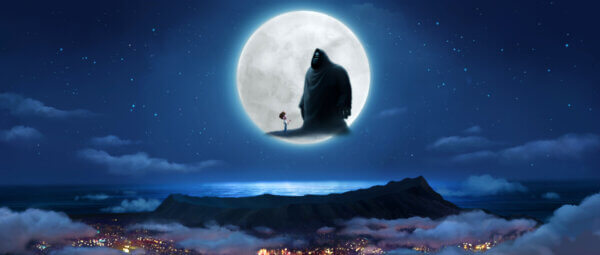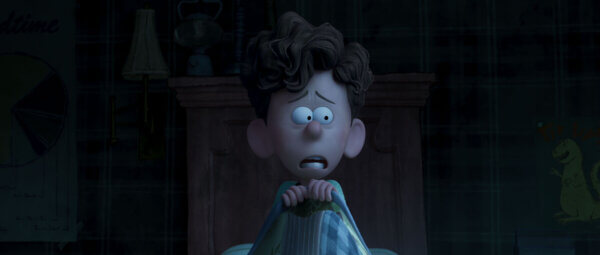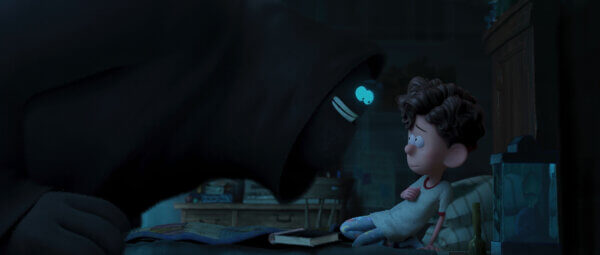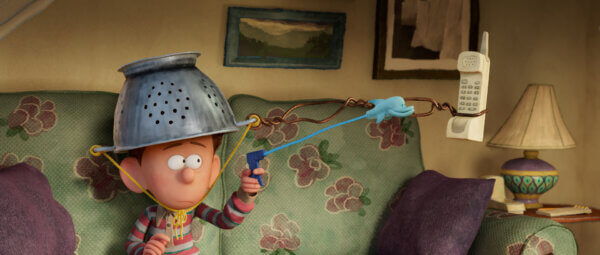Interview with Sean Charmatz, Director of Orion and the Dark
DreamWorks’ Orion and the Dark is a balm for the anxious. In detailing the story of an elementary school boy who is scared of putting the slightest foot wrong, the film is one for a modern generation of kids growing up under the pressure to be perfect. Orion’s fears range from bees, to bullies and accidentally flooding the school, with his greatest fear being the dark. The manifestation of Dark, along with the other “night entities;” Insomnia, Sleep, Unexplained Noises, Quiet and Sweet Dreams, whisk Orion off on a tour through the night to help him understand the value of darkness and overcome his fears.
Orion and the Dark is the second animated film directed by Charlie Kaufman after the self-directed Anomalisa. Kaufman is known for peering into the minds of his protagonists and tackling abstract concepts, and this is no different. Tasked with bringing Kaufman’s script to life within a Hollywood animation context is Sean Charmatz, making his feature debut after being at the helm of various DreamWorks shorts and specials. His work as a story artist has seen him contribute to such projects as The Spongebob Squarepants Movie and The Lego Movie 2.
Skwigly caught up with Charmatz over Zoom to discuss the big swings of Kaufman’s script, maintaining a 2D identity for the film and pulling off ambitious visuals on a smaller budget.
I related so much to Orion as a character. There’s a moment at the start of the movie where he’s listing all the things that he’s fearful of and one of them was “saying ‘good morning'”. As a kid, I was so scared of messing up the slightest thing. Did you see yourself in the story in that way?
Well put it this way, that’s a fear I added to Charlie [Kaufman]’s list. That one and “clogging the toilet” are ones I added to what Kaufman already had there. My production designer Tim lamb and I say “good dorning” to each other because we just think it’s funny. It’s so relatable because I added that to the script.
How did Kaufman’s script find its way to DreamWorks?
I think DreamWorks is aware of the whimsy and the inventiveness and the charm and depth of Charlie’s writing and they were like, “let’s try and make an animated movie with all that stuff in there,” and I commend them for that. He wrote three drafts and we loved the third draft which came to me a few years after he had written it. I put together this animatic, where I was the voice of Dark and my son was Orion and I made this four minute piece based on Charlie’s script. I showed the studio and they loved it.
How difficult was it to kind of swing some of the big ideas that Charlie puts into the script? There’s talk of nihilism, abstract concepts, there’s a David Foster Wallace reference in the first 20 minutes.
Honestly, the studio was supportive because we were going to go to streaming and they were more willing to let the film be purely what it is. It just was me and my team believing in the script and the studio believing in the script as well. As we started to put up reels and stuff, we were having executives crying by the end because the movie touched them. And so it was fairly easy to keep all of those crazy things in there. I don’t think they’re “crazy,” but I can see why they’re unique and surprising for audiences. There were things we had to cut out. There was a whole page where Charlie listed the titles of films with Dark in it, because Dark was talking about how he’s hated. Charlie took the entire script page to name films. Obviously, in the movie, we can’t spend 10 minutes listing titles of movies. No one’s going to sit through that but it’s still really fun to read it.
That could’ve been pretty fun.
It would have been 10 minutes of listing, just a static shot. As an artist, I love that, I love how pushed that is. It’s really inspiring to me. I love that statement.
There’s a moment near the start of the movie where Orion’s watching a cartoon and he says, “I don’t appreciate being condescended to.” Was the mission statement for this film to make an animated movie that kids don’t feel like is talking down to them?
It wasn’t the mission of the movie, that was something that Charlie had written. But I love that statement. I do often feel like people aren’t giving the audience enough credit. The audience is so smart. They’re able to take in so much media now.
100%, I have young nephews and nothing gets past them.
My kids give me the best notes. I’ll show them something and my daughter will give me a note that is really good. So I know because of my own kids that they can give you better notes sometimes than adults and I definitely respect that audience.
This movie has a lot of 2D DNA, I love the mixing of 2D and 3D. Was it important to you to retain that 2D identity?
I would say it wasn’t important to me, but that it was essential and just part of the DNA of the film. I’ll make another movie and maybe there won’t be any 2D in it because that’s not what the film needed. But because Orion draws in a sketchbook, it felt very appropriate. It helps feel like the movie is being told through the voice of your main character. It was more what we felt was appropriate for this film, as opposed to me fulfilling my needs as an artist. I’m always going to take every movie as its own beast, and some might get the 2D treatment and some may not.
Could you talk about the unique challenges of blending the CG characters with 2D environments?
It was just a look. Tim lamb is our production designer, and this is something that he thought would look cool and would be something that looks very beautiful and finished while also having limitations with the budget. For us, it was definitely part of what we were working with in terms of time and money with this style. We also felt it was something that we could pull off and people would love it and feel like it’s as beautiful as those $90 million movies, but also has a unique character. I think that the Spider-verse thing is really smart because it’s comic books, right? So you should lean into that. That’s what’s cool about some of these movies is they’re just leaning in fully to the material. So we did the same thing. We leaned into the material and did something we thought was appropriate tonally for the film, but also something we felt was producible and would be beautiful in the end.
I feel like the film has quite cartoonish characters, you have these character models with their eyes very close together, and some exaggeration in the design. Can you talk about developing the character models?
I’m a huge Gary Larson fan, I’m a huge Simpsons fan, so I’m a fan of the eyeballs with the little pupils. Tim Lamb did like 30 Orions and Joe Pitt did like 30 Orions, and there was one that Tim drew that was Orion in a therapy lounge, laying there, nervous. That drawing was the one where I was like, “that’s Orion.” Because that drawing had the ping pong ball eyes, everything kind of designed out from Orion. That design language was informing the other human characters in terms of how we were going to approach design. I would say that the hair was a huge accomplishment for us because we have linework in the hair and no one knew how to do that. There wasn’t any “do it like this movie,” which is often what we can do. We didn’t really have that and we didn’t have a ton of time. The hair was a huge design hurdle for us and we finally landed on something we all love.
There are these sequences where the landscape is changed from day to night as Orion and Dark dash cross it. Could you talk about developing those sequences?
We always wanted the night to spread like ink does on paper. That’s a very 2D approach. Not every shot feels like that, but my favourites are the ones where he goes right to left across the screen and you see the ink almost absorbed into the frame, which is really cool because I’ve never seen that before.
What was the process of designing Dark and the other night entities?
I always thought that the entities would be from different planets and I thought that it would be cool if they’re a team with characters that look like they’re from different films, they’re totally different from each other. I thought that made the entities feel larger than life, godlike entities and so that was kind of the launching point for everyone. They’re each from a planet. I also wanted there to be so you can’t quite pin down what they are. Quiet is a dandelion mouse, which is not really a thing. I love that. Unexplained Noises is like a robot foley artist, a self serious actor. Sleep, to me, is like a muppet type of puppet. We always said it’s like a worn out teddy bear.
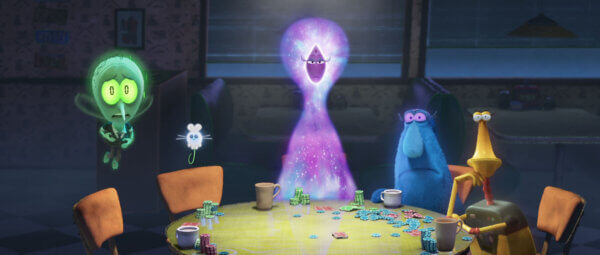
Orion and the Dark – Nat Faxon as Insomnia, Aparna Nancherla as Quiet, Angela Bassett as Dreams, Natasia Demetriou as Sleep and Golda Rosheuvel as Unexplained Noises. Cr: DreamWorks Animation © 2023
They remind me a bit of Totoro where you can easily identify him as an animal, but he’s not quite an owl, or a bear, or a cat. He’s like something beyond nature.
At first with Quiet I was thinking it could be like a deer because you have to be quiet in the forest, but if it’s just a real thing, we can go “that’s a deer or that’s a cat or that’s a dog” and it feels less special. Just like you’re saying with Totoro which I love, I’ve made lots of Totoro art myself. I think not being able to pin down what Totoro is makes Totoro special and pop and memorable. So we did the same thing with the entities you can’t quite pin down what they are, but you’re like, “oh yeah, that’s a mouse kind of that floats and flies, but also a dandelion. But when you think about it, a dandelion floating in the air has no sound and is quiet. It is peaceful, serene, so it was a perfect combination. And I’ve made a lot of art myself outside of the studio with dandelions, if you look at my timeline on Instagram, so it’s cool to insert me into some of this as well.
How was the experience of directing Werner Herzog?
We just wanted him to do what he does. Sometimes as a director, you just say “hi Werner Herzog. Nice to meet you. Great honour.” He goes in. He does what he does, and then it’s like, “Thanks, we got it.” I think that the recording session was 20 minutes long. He did it four times, we could have used any of them and it would have been perfect. He signed my script, which was really cool. And I mean, I love that part of the movie. I love that we get to give Saul Bass a shout out because he’s one of my favourite artists of all time. The Vertigo poster was in my bedroom for like, a decade. That’s what I woke up to in the morning. I don’t know why, but I just felt like it needed to be near me as an inspiration.
Orion and the Dark is now streaming on Netflix.


